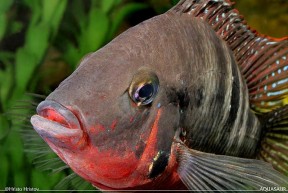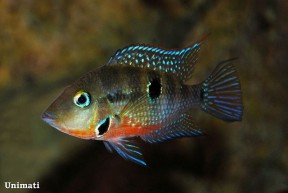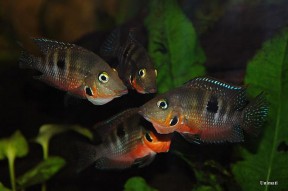Thorichthys meeki
Firemouth Cichlid
SynonymsTop ↑
Thorichthys helleri meeki Brind, 1918; Cichlasoma meeki (Brind, 1918); Herichthys meeki (Brind, 1918); Cichlasoma hyorhynchum Hubbs, 1935
Etymology
Thorichthys: from the Ancient Greek θρῴσκω (throsko) meaning ‘to leap, spring’, and ἰχθύς (ikhthús), meaning ‘fish’.
meeki: named in honour of American ichthyologist Seth Eugene Meek (1859-1914), compiler of the first book on Mexican freshwater fishes.
Classification
Order: Perciformes Family: Cichlidae
Distribution
Its natural range extends eastward from the Río Tonalá system near Coatzacoalcos, on Mexico’s Atlantic slope, through the states of Veracruz, Chiapas, Tabasco, around the Yucatán Peninsula, then southward into northern Belize and Guatemala.
Type locality is given simply as ‘Near Progreso, Yucutan, Mexico’.
Naturalised populations exist in Hawaii (since 1940), and Puerto Rico (since the late 2000s), plus there are reports from Arizona and Florida states, USA.
Habitat
Has been collected from a diverse range of lowland biotopes characterised by still to moderately-flowing, relatively shallow (depth <1.5 metres), clear-to-muddy, fresh-to-slightly brackish water, including cenotes, lagoons, roadside pools, spring-fed ponds, ditches, streams, and minor tributaries.
Substrates may be composed of sand, mud, marlstone, or travertine limestone while aquatic vegetation may be absent, or composed of algae, Myriophyllum, Potamogeton, Eichhornia, Nymphaea, Carex, and Typha species.
Beds of leaf litter and submerged branches and other woody structures are other common habitat features.
Other cichlid species found in the area include Amphilophus robertsoni, Rocio octofasciata, ‘Cichlasoma‘ salvini, Parachromis friedrichsthalii and ‘Cichlasoma‘ urophthalmus, Paraneetroplus bifasciatus, P. synspilus, Petenia splendida, Theraps heterospilus, T. pearsei, Thorichthys helleri, and T. pasionis.
Additional sympatric species include Poecilia petenensis, Poecilia mexicana, Gambusia sexradiata, Carlhubbsia kidderi, Phallichthys fairweatheri, Belonesox belizanus, Xiphophorus hellerii, Rhamdia guatemalensis, Atherinella alvarezi, Astyanax aeneus, Hyphessobrycon compressus, Dorosoma anale, D. petenense, and Cynodonichthys tenuis.
Maximum Standard Length
100 – 120 mm.
Aquarium SizeTop ↑
Base dimensions of 120 ∗ 30 cm are acceptable for a single pair, but it generally does best in larger aquaria alongside both conspecifics and other species.
Maintenance
Provided adequate cover and structure is available this species is unfussy with regards to décor with ceramic flowerpots, lengths of plastic piping and other artificial materials all useful additions.
A more natural-looking arrangement might consist of a soft, sandy substrate with smooth rocks plus some driftwood roots and branches placed in such a way that plenty of shady spots and caves are formed.
Since it naturally inhabits pristine environments water quality is of the utmost importance, and the fish should never be introduced to a biologically immature aquarium.
Water Conditions
Temperature: 20 – 32 °C
pH: 6.5 – 8.5
Hardness: 36 – 268 ppm
Diet
Thorichthys species are primarily benthophagous omnivores with wild individuals often feeding on small crustaceans such as copepods and cladocerans, plus other invertebrates, molluscs, and organic detritus.
Mouthfuls of substrate are typically taken and sifted for edible items with the remaining material expelled via the gill openings and mouth.
Captive specimens are relatively unfussy but should nevertheless be offered a varied diet comprising high quality, fine-grade prepared foods plus live or frozen chironomid larvae (bloodworm), Tubifex, Artemia, mosquito larvae, etc.
At least some of the dried products should contain a significant proportion of vegetable matter such as Spirulina or similar.
Home-made, gelatine-bound recipes containing a mixture of dried fish food, puréed shellfish, fresh fruit and vegetables, for example, are proven to work well and can be cut into bite-sized discs using the end of a sharp pipette or small knife.
Behaviour and CompatibilityTop ↑
Not especially aggressive, though territorial when breeding and may eat much smaller fishes. It can be kept with similarly-sized Central American cichlids but provide enough space to allow each species to form an adequate territory.
Groups of peaceful upper-water dwelling fishes can also be included with the genera Poecilia and Xiphophorus particularly suitable since they have representatives in Mexico.
Unless spawning, Thorichthys species are quite gregarious and do best when maintained in groups of 8 or more individuals.
Sexual Dimorphism
It is difficult to sex younger fish but adult males tend to grow larger, develop more extended dorsal- and anal-fin filaments and are more intensely-coloured than females, especially when in spawning condition.
Reproduction
A biparental, monogamous substrate spawner that is easily-bred when in good condition. There doesn’t appear to be any particular trigger for the spawning process with the main requirements being good diet and stringent maintenance regime, although wild fish may be more seasonally-orientated.
Unless sexed adults are available it’s best to begin with a group of young fish and allow pairs to form naturally, separating them as they do so.
The eggs are normally laid on a solid surface such as a flat rock, piece of driftwood, broad plant leaf, or directly on the aquarium glass. Young or inexperienced pairs may eat the first brood(s), particularly if they feel threatened or are disturbed.
Spawning occurs in typical style with the female laying one or more rows of eggs before the male moves in to fertilise them, the process being repeated numerous times until she is spent.
Several hundred eggs may be deposited and the female stays close to them during the incubation period, tending and defending against intruders, while the male is responsible for defence of the surrounding territory.
If maintaining the adults in a community situation it’s recommended to remove either tankmates or eggs at this point should you wish to raise good numbers of fry.
The latter are easily-fed, accepting good quality powdered dry foods, Artemia nauplii, microworm, etc., as soon as they become free-swimming stage (normally 4-5 days post-spawning). Parental care can continue for several weeks.
NotesTop ↑
This species has been a popular aquarium fish for a considerable period and virtually all fish traded are now raised commercially for the purpose.
It is easily identified by the characteristic bright red or orange underside of the head, which is more pronounced in adults.
Following Miller and Taylor (1984), the genus Thorichthys is identified by the following combination of characters: soft dorsal and anal fins without scales; caudal fin truncate to lunate, outer rays typically elongated as filaments in adult; pectoral fin long and pointed, tip extending beyond anal-fin origin; snout pronounced, preorbital region typically deep; uniform development of five (rather than four) mandibular pores; precaudal vertebrae almost always 12 (vs 13 or more); colour pattern comprising a series of five or six vertical bars along flank, the third intensified as a blackish blotch on midside that often extends over both upper and lower lateral lines; intermandibular region strikingly coloured, ranging from orange to salmon to red or rose (black in T. pasionis); subopercle typically with a conspicuous dark blotch (almost invisible in T. callolepis and reduced in T. pasionis and T. socolofi); head, nape and anterior parts of body often with prominent chalky or iridescent blue to turquoise spots that may also be developed on vertical fins.
Thorichthys is generally considered to represent a monophyletic species group. It was described within Cichlasoma by Regan, then a subgenus, and finally elevated to generic rank by Kullander (1983). Molecular and morphological analyses have supported this monophyly, but its evolutionary position in terms of other Middle American cichlid groups is still in question.
References
- Brind, W. L., 1918 - Aquatic Life v. 3: 119-120
A new subspecies of Thorichthys helleri. - Artigas Azas, J. M., 1995 - Cichlid Press, Germany: 63-67
Thorichthys meeki, the firemouth, in the wild. In: The Cichlids Yearbook 5. - Chakrabarty, P., 2007 - Miscellaneous Publications, Museum of Zoology, University of Michigan No. 198: i-iv + 1-31
A morphological phylogenetic analysis of Middle American cichlids with special emphasis on the section 'Nandopsis' sensu Regan. - Meek, S. E., 1904 - Bulletin of the Bureau of Fisheries 41(985): 237-287
The fresh-water fishes of Mexico north of the isthmus of Tehuantepec. - Miller, R. R., 2006 - Chicago (University of Chicago Press): xxvi + 1-490
Freshwater fishes of México. - Miller, R. R. and J. N. Taylor , 1984 - Copeia 1984(4): 933-940
Cichlasoma socolofi, a new species of cichlid fish of the Thorichthys group from northern Chiapas, Mexico. - Page, L. M. and B. M. Burr, 2011 - Peterson Field Guide.: 1-663
Peterson Field Guide to Freshwater Fishes of North America North of Mexico (Second Edition). - Roe, K. J., D. Conkel, and C. Lydeard, 1997 - Molecular Phylogenetics and Evolution 7(3): 366-376
Molecular Systematics of Middle American Cichlid Fishes and the Evolution of Trophic-Types in ‘Cichlasoma (Amphilophus)’ and ‘C. (Thorichthys) - Říčan, O., R. Zardoya, and I. Doadrio, 2008 - Molecular Phylogenetics and Evolution 49(3): 941-957
Phylogenetic relationships of Middle American cichlids (Cichlidae, Heroini) based on combined evidence from nuclear genes, mtDNA, and morphology.







May 27th, 2014 at 1:36 am
This profile should have picture of a fish in better condition.
June 3rd, 2014 at 6:42 pm
Hi Rey, better now?
June 6th, 2014 at 2:42 am
@Matt. Nice photos and good job.
June 7th, 2014 at 12:43 am
Reckon we could do with a few more pics but glad you’re happy with the improvement. Cheers.
June 16th, 2014 at 10:59 am
Cichlid Profiles said this fish grows up to 6-inches…